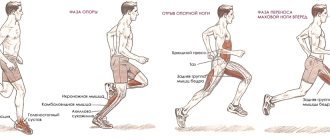The fear of running usually develops at school age, when teachers do not pay enough attention to running technique. For children who have not been taught how to breathe properly when running, even passing standard standards turns into torture! It is not surprising that many adults categorically declare: “I hate running because I’m out of breath.” But you don’t have to choke at all!
Proper breathing begins with a warm-up
The beginning of each workout is accompanied by a warm-up. This is not only a way to significantly reduce the chance of injury, but also prepares the muscles for stress. Without a warm-up, the effect of the exercise decreases, since the body has not had time to adapt to the load. Work-in plays an important role here. For some it happens quickly, for others it takes longer. BUT! The importance of working in cannot be underestimated.
Therefore, before running, it is necessary to perform several standard exercises that will warm up the muscles and respiratory organs.
The standard set of exercises includes:
- rotation of the head, shoulders;
- body turns and bends;
- lunges, squats;
- light bouncing;
- kneading the ankle (an important point for running).
Large muscle groups need to be used. The number of repetitions of each exercise is from 8 to 32 times.
During the warm-up, it is important to choose the right rhythm, which will allow you to not lose your breath and will contribute to the best result. Try to inhale while expanding the chest, exhale while compressing. To make it easier to remember, exhale when muscles tense, inhale when relaxing.
During maximum tension when performing an exercise, do not hold your breath. This can lead to dizziness, darkening of the eyes, increased intravenous pressure, and general poor health. Try not to pause while repeating.
A complete guide to breathing properly when running long distances
Deep breathing can also be called abdominal, diaphragmatic, or belly breathing.
In this article, the terms will be used interchangeably (although formally they designate different states, but we’ll talk about that another time).
In essence, belly breathing is a breathing technique that is performed through the action of the diaphragm. The air is inhaled deep into the abdominal cavity, thus the body receives a full supply of oxygen.
What is a diaphragm?
The diaphragm is a dome-shaped muscle located in the lower part of the chest, separating the chest from the abdominal cavity.
This muscle regulates the breathing process.
When you inhale, the diaphragm contracts along with the intercostal muscles and moves downward, pressing on the organs in the abdominal cavity, which, as a result, expands as the lungs fill with air.
When you exhale, the diaphragm relaxes along with the intercostal muscles, rising up to the center of the chest, displacing carbon dioxide from the lungs.
Misconceptions about chest breathing
Most runners breathe from the chest—called “shallow breathing”—rather than from the belly.
In fact, most people breathe this way, inhaling less oxygen than the body needs and exhaling less carbon dioxide than the body needs.
This ineffective breathing can lead to fatigue, lethargy, shortness of breath, etc.
Think of chest breathing as trying to breathe through a straw. Not a very effective way, is it?
Deep breathing can be learned
If you are confused by the above, don't be embarrassed.
You don't have to become an expert on human anatomy to learn how to breathe from your diaphragm.
Although this breathing method is not often used, deep breathing is an innate skill that can be learned through practice. This is by no means a skill only for the elite.
Benefits of Deep Breathing
Basically, deep breathing helps:
- Lower blood pressure
- Relax muscle tension
- Reduce stress
- Improve posture
- Reduce inflammation
- In the treatment of chronic obstructive pulmonary diseases (COPD)
- In solving cardiovascular problems
- Improve blood flow
- Boost your energy levels
- Lower blood sugar levels
- Increase serotonin release
- Increase secretion of growth hormone
- In body detoxification, etc.
The list of benefits of deep breathing for fitness, health and overall well-being goes on, but the overall picture shown here is enough to get the point across.
How to do this in practice?
So, you may be wondering how to make this method work for you.
The short answer is constant practice. The more you practice, the sooner you will achieve the desired result. There are no other ways.
But what should be done?
The long answer is given here as an exercise.
Note : The breathing exercise described below is similar to the breath work in traditional yoga. If you've ever done yoga, this exercise will be a no-brainer. If not, be careful and take it slowly.
Classic deep breathing exercise
First of all, find a comfortable, quiet place where you won't be disturbed. This exercise is performed while sitting cross-legged or lying comfortably on your back. Just make sure your back is straight and your muscles are engaged.
Then, close your eyes, place one hand on your chest and the other on your stomach, just below your ribs.
Take a slow, deep breath through your nose. Imagine that you are sucking in all the air in the room.
Focus on your breathing until you feel your belly expand, then fall sharply, and your chest expand.
As you inhale, the hand on your stomach will rise higher than the hand on your chest. This will be evidence that the diaphragm is sucking air into the lungs.
Then exhale slowly through slightly pursed lips. Make sure your stomach drops and as much air is expelled from your lungs as possible.
There is no need to force your belly to fall by tensing your muscles. The movement and flow of air should be smooth.
When the belly breathing exercise is done correctly, you will feel and see your stomach rise and fall without moving your hand on your chest.
This exercise will help you feel the difference when breathing with your stomach and chest.
How it's done?
Alternate between normal and deep breaths for several minutes. Notice how you feel during your normal breathing and during deep breathing when the diaphragm is active.
Most people feel tightness and constriction when breathing through the chest, while deep breathing relaxes and makes breathing easier.
How often should I exercise?
You should do this exercise at least twice a day or before training as a warm-up.
You can also breathe from your diaphragm during times of stress, or when you feel like the world is too difficult for you.
Need to practice regularly
Belly breathing may seem uncomfortable at first, but with regular practice it becomes second nature.
Once you have mastered diaphragmatic breathing while lying on your back, begin introducing it while running, preferably over short to medium distances.
You should not breathe deeply at the start.
Instead, jog slowly, and once you're warmed up, engage your abs and muscles as in the exercise above.
Your goal is the same. You should breathe as deeply as possible, feeling the contraction and expansion of your abdomen. Then exhale in a relaxed state.
Increase your workout intensity
After deep breathing at low to moderate intensity during your run, increase your intensity.
In this case, more physical force will be applied to your respiratory system, but it is necessary.
Practice rhythmic breathing
You can synchronize your breathing with the rhythm of your running. For example, inhale for three steps and exhale for two, a technique known as rhythmic breathing.
This breathing method makes it easier to take deep nasal breaths and then full exhalations through the mouth. In this case, you remember to breathe all the time.
"Open" your chest
Proper technique, especially for the upper body, is an additional method for effective deep breathing.
You need to run without bending, with a slight lean forward. Keep your chest straight, your back should be straight, and your shoulders should be relaxed. Don't slouch, even on climbs.
Consider adding a couple of exercises to your strength training program to target your abdominals and lower back muscles so you can maintain good posture over the long haul.
Consider Pilates as well, as these exercises also help build breathing strength and endurance.
How to breathe while running
Breathing primarily affects the cardiovascular system. While running, the athlete's heart rate reaches a rate that is 2-3 times higher than at rest. Thus, blood flow to muscles and organs increases, which allows tissues to be saturated with oxygen. Breathing in this case can help increase the effect and duration of exercise.
Breathing when running should be measured and not intermittent. A slight hitch can lead to a “knocked down” respiratory cycle. As a result, coordination of movements is disrupted, and jogging becomes uncomfortable.
An important indicator is oxygen debt. This is a feeling of lack of oxygen when you want to breathe more often. Oxygen debt occurs in any case. There are ways to reduce it.
So, if you are jogging slowly, it is recommended to breathe every 3-5 steps. This is the simplest option when the need for oxygen is insignificant.
If the workout consists of running at a moderate pace, the breathing rate is usually higher. In an effort to relieve oxygen starvation, the runner breathes more often. Therefore, in this case, the breathing rhythm is 2-3 steps per cycle.
Sprinting makes it almost impossible to maintain a breathing rhythm. Sprinting is the most intense exercise that maximally utilizes all muscle groups, but for a short time. Inexperienced runners try to run the entire distance while holding their breath. This is wrong because the result suffers. Despite the difficulties with control, you still need to breathe.
If, following the suggested options, you feel a sharp lack of oxygen or, conversely, your breathing is too frequent - look for your rhythm. Each person has their own characteristics and different levels of fitness. Learn to control your breathing and then you can build a suitable rhythm. Inhale up to 50% of your lung volume and exhale at a moderate pace.
Breathe not shallowly, but deeply
Denis Vasiliev, coach of the running club Runlab Running Laboratory, St. Petersburg:
– First of all, you need to breathe through your mouth. Running is not an easy task. It’s probably not worth complicating your task even more by inhaling through your nose while running. Secondly, you should breathe not superficially, but deeply. Try to include the diaphragm and abdominal muscles in the breathing process (the exception is running in frosty weather). As for the rhythm of breathing, perhaps it is individual for everyone. There are many options: “inhale for three steps, exhale for two,” “inhale for two, exhale for two,” etc. And they are all justified. But I myself have never counted rhythm and I know few people who use this technique.
Breathing techniques while running
Practical variations of breathing techniques while running will allow you to better understand the basic principles, as well as choose the appropriate option for the task at hand.
Two plus one
An interesting technique that you can try while doing slow running. Take two short breaths and one deep exhale. Surprisingly, in two short breaths the lungs fill quite a lot. This was big news for me.
It is not recommended to use the technique at a moderate or fast pace, because your breathing will almost certainly become difficult.
Rhythmic breathing
The peculiarities of the movements are such that inhalation and exhalation occur on different legs. For example, we always inhale on the right leg and exhale on the left. Solving the problem is quite simple. Use odd breathing running. That is, try to keep the cycle consisting of 3.5 or 7 steps. Thus, the inhalation-exhalation phases will alternate.
A similar method is used by swimmers doing front crawl. This technique allows you to swim in the middle of the track.
Breathing on a count
The technique allows you to control the rhythm throughout the entire run. Often used by beginners who have set a goal to learn proper breathing.
Emphasize exhalation
Yana Khmeleva, founder and head coach of the Bestia.club running school:
– When running, it is better to breathe through your mouth and focus on exhalation. Why? Quite a bit of oxygen passes through the nose. Not enough to run. Especially if you run fast. The only advantage of breathing through the nose is that the air in the nose heats up. If we are talking about running at -10 degrees and below, then it is better to wear a buff or run in an arena, because even if you breathe through your nose, you can catch a cold.
If you breathe through your nose, shortness of breath will occur, it is inevitable. Imagine the Olympic Games or the World Championships: an athlete is running 100 meters, 200 meters, a marathon - it doesn’t matter. He's in a finishing rush, and he's breathing through his nose as he counts. One-two. Inhale. Three four. Exhalation. One-two. Three four. Nobody breathes like that. Therefore, there is no need to do any counting breathing. You need to breathe through your mouth and focus only on exhalation.
The myth about proper breathing
The basic principle that everyone was taught is inhale through the nose, exhale through the mouth. If you try to perform such a breathing cycle at rest, you will most likely experience an attack of yawning. Often, with this method of breathing while running, you may feel dizzy. What this technique is really good for is restoring breathing. The best publicly available method has not yet been found - take a deep breath while rising on your toes and exhale your arms out to your sides.
However, one should not say that the well-known breathing technique was invented without reason. The main basis for its appearance was the functional features of the nose and mouth.
During active breathing while running, the nasal mucosa traps microorganisms and prevents them from getting inside. This reduces the risk of getting sick. There is no mucous in the oral cavity, so microbes feel quite comfortable. This is all that technology can boast of. For practical use it is complex and even incorrect.
The ideal option is mixed breathing. It is based on simultaneous inhalation through the nose and mouth, which allows you to breathe more comfortably and speed up the delivery of air to the lungs.
Breathe in a way that is comfortable - this is the main principle of proper breathing. Try to keep oxygen deprivation to a minimum. Find the ideal breathing rhythm for yourself and learn to control it. Constant control will allow you to practice the skill until it becomes automatic and the need to constantly monitor your breathing technique will disappear on its own.
How to breathe correctly to increase your oxygen supply
While running, practice deep and even breathing. Completely force all the air out of your lungs so that you can take in as much oxygen as possible on your next breath.
And in order to increase your lung capacity, you can perform simple breathing exercises from time to time:
- Blow up balloons. By doing this regularly, you will soon notice that your lungs are getting better at pumping air and becoming stronger.
- Another equally fun way to increase your lung capacity is to attach a long strip of paper to your nose and blow on it, trying to keep it in a horizontal position for as long as possible.
- Play wind instruments or just sing!
Content
- How to breathe correctly when running 1 kilometer?
- How to breathe correctly when running 3 kilometers?
- How to breathe correctly when running to lose weight?
Speaking about proper breathing, you need to understand that this concept is rather arbitrary, since each of us has an individual respiratory process. But there are certain universal breathing techniques that you can use while jogging to use your body's abilities at 100%.
However, the use of techniques varies depending on the running exercises being performed. Running is a continuous and cyclical exercise . Controlling your breathing during it is very important.
In addition to running and playing sports, there are other ways to improve your health, learn more about yourself, relieve muscle tension, and so on. One of these methods is called holotropic breathwork. You can read more about this procedure in the article holotropic breathing technique, find out how to breathe correctly!
What are the indications for visiting a cryosauna? You can find out here. Let’s preserve our health with the help of the latest achievements of progress!











